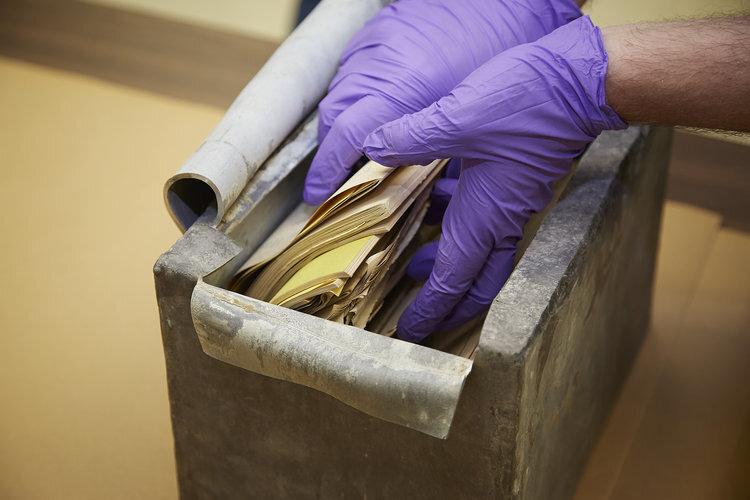This article was originally published in 2013.
For The First National Bank of LaGrange (FNBLG)’s prized collection of Presidential Checks to be properly conserved for the first time in more than 20 years, they turned to The Conservation Center’s team for 21st century solutions.
First of all, each delicate check had to be lightly surface cleaned, in addition to the meticulous removal of adhesive left behind from old framing. Each check then undertook controlled passive humidification in a Gore-tex package and then was flattened out and dried between cotton blotters under weights.
After proper cleaning, the checks were assembled into, new, narrower profile frames with an antique black finish, with ½” smaller mat margins set to conservation standards, and protected by Conservation Clear acrylic glazing that protects against UV light rays. The new archival step mats include antique white mats on the top with charcoal gray mats beneath. The layout features the portrait of each president in an oval opening at the top and a rectangular opening below the portrait, which feature the president’s name and birth/death dates along with a line about the president provided by the bank. Four additional frames were provided for future presidential checks that have not made it to the collection.
The Conservation Center is extremely honored to have preserved such a rare collection of historical artifacts, and we can’t wait to see the checks on public display again in FNBLG’s lobby. We heard that the bank staff is preparing for a Presidents Day unveiling in 2014, so we’ll be sure to keep you updated.
___________________________________________
As told to The Conservation Center by Marty Madden, Executive Vice President and CFO, The First National Bank of LaGrange:
“My father John R. Madden set out to start a presidential check collection more than 40 years ago. Working with collectors, dealers, and historians throughout the United States, he finally amassed an impressive collection of 25 checks by the early 1970s. By 1974, the bank had its first exhibit of the Presidential Check Collection.
Each check, beginning with George Washington's dated November 18, 1797, represents a unique piece of history. Today, FNBLG owns a truly exclusive—and perhaps the most comprehensive—collection of checks written by 39 of the 43 Presidents of the United States. These checks are authenticated, insured, and continue to be on display on our lobby walls for public enjoyment.
As historical financial records, our collection raises many interesting questions. For instance, Abraham Lincoln paid himself a monthly salary of $800 on March 15, 1865, less than one month before his assassination. Imagine what $800 in cash would equal in today's dollars? Assuming a 3% inflation rate, our calculations come out to $48,507.94!
Teddy Roosevelt's check, dated November 29, 1912, was written to a Milwaukee physician six weeks after he was shot in the chest in Milwaukee while campaigning on the "Bull Moose" ticket. Not only did Roosevelt survive the attack; he also completed his speech! Roosevelt later commented, "I did not care a rap for being shot. It is a trade risk, which every prominent public man ought to accept as a matter of course." Dr. George W. Hochrein eventually helped save Teddy Roosevelt's life.
In 1948, while supporting Harry Truman's campaign, Ronald Reagan wrote a $50 check to Americans For Democratic Action, one of the nation's oldest liberal political organizations. It was not until 1962 when Reagan officially switched his allegiance to the Republican Party.
Many of the checks serve as reminders of the “good old days” when you could live very comfortably on $85.00 a week. For example, Warren Harding's monthly utility bill at Potomac Electric was only $4.70 in 1919, and it only cost Lyndon B. Johnson $3.00 to renew his driver's license with the Texas Department of Public Safety in 1965.
Some presidential checks were harder to find than others, due to supply and demand. Presidents usually don't pay their own bills, and especially when you’re from a wealthy family—such as in John F. Kennedy’s case—a check with his signature was especially difficult to find. Our most recent acquisition occurred about 10 years ago was a John Tyler check dated 1840. We are still on the hunt for canceled checks written by Zachary Taylor, George H.W. Bush, Bill Clinton, George W. Bush, and Barack Obama.
Going forward, the "paperless transactions" of wire transfers, Internet banking and electronic bill payment may require us to revisit our check collection strategy. Politics aside, could an expired debit card from Bill Clinton ever hold a candle to Abraham Lincoln's check?”











